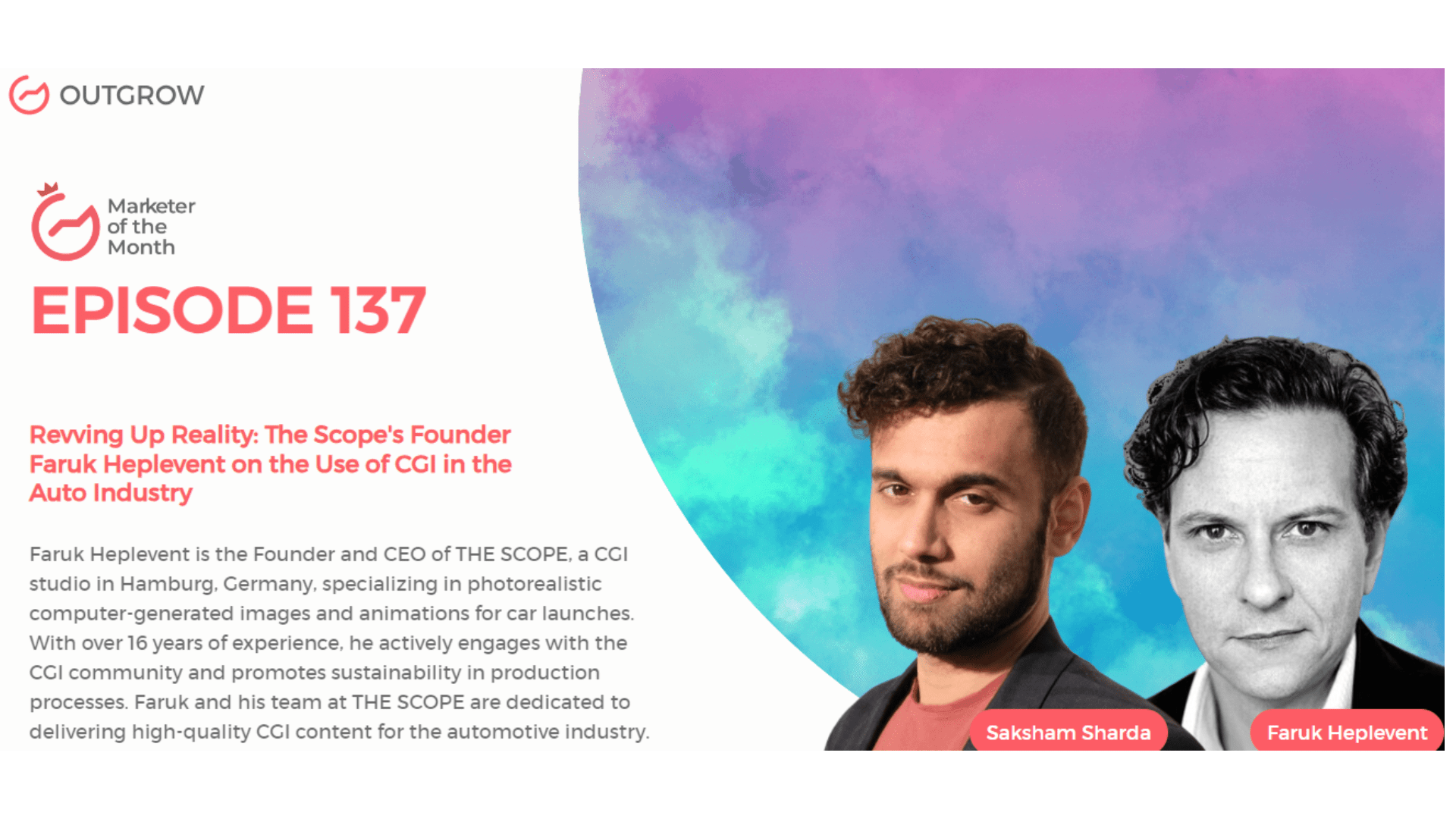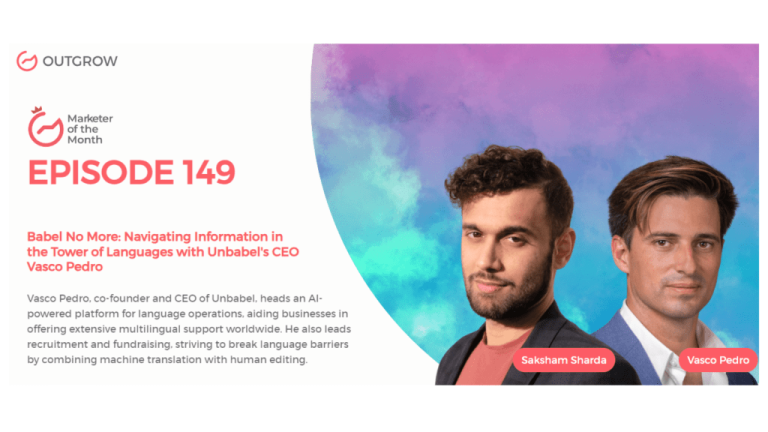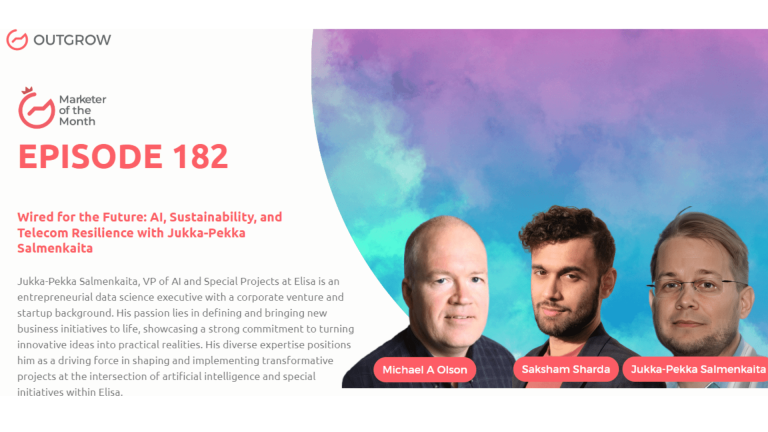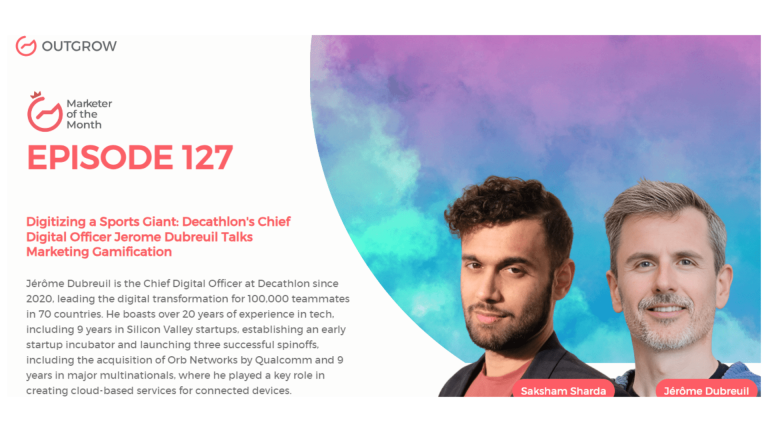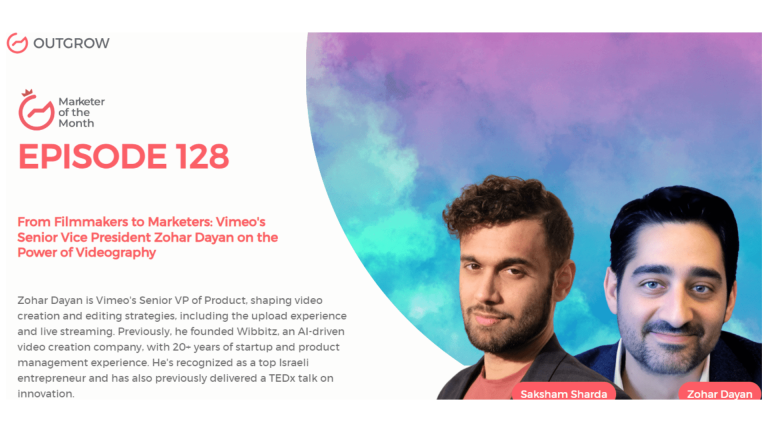EPISODE 137: Marketer of the Month Podcast with Faruk Heplevent
Table of Contents
Hey there! Welcome to the Marketer Of The Month blog!
We recently interviewed Faruk Heplevent for our monthly podcast – ‘Marketer of the Month’! We had some amazing insightful conversations with Faruk and here’s what we discussed about-
1. CGI’s role in automotive content creation.
2. The recent surge in meditation’s popularity.
3. AI and automation in CGI workflows.
4. The Scope City Tech Demo: a CGI city-building tool.
5. Emphasis on sustainability in CGI production.
6. Metaverse’s potential impact on the CGI industry.
About our host:
Dr. Saksham Sharda is the Chief Information Officer at Outgrow.co. He specializes in data collection, analysis, filtering, and transfer by means of widgets and applets. Interactive, cultural, and trending widgets designed by him have been featured on TrendHunter, Alibaba, ProductHunt, New York Marketing Association, FactoryBerlin, Digimarcon Silicon Valley, and at The European Affiliate Summit.
About our guest:
Faruk Heplevent is the Founder and CEO of THE SCOPE, a CGI studio in Hamburg, Germany, specializing in photorealistic computer-generated images and animations for car launches. With over 16 years of experience, he actively engages with the CGI community and promotes sustainability in production processes. Faruk and his team at THE SCOPE are dedicated to delivering high-quality CGI content for the automotive industry.
Revving Up Reality: The Scope’s Founder Faruk Heplevent on the Use of CGI in the Auto Industry
The Intro!
Saksham Sharda: Hi, everyone. Welcome to another episode of Outgrow’s Marketer of the Month. I’m your host, Dr. Saksham Sharda, and I’m the creative director at Outgrow. co. And for this month we are going to interview Faruk Heplevent who is the Founder and CEO of THE SCOPE.
Faruk Heplevent: Great to be here. Thank you.
Don’t have time to read? No problem, just watch the Podcast!
Or you can just listen to it on Spotify!
The Rapid Fire Round!
Saksham Sharda: So Faruk, we’re gonna start with the rapid-fire round. Just to break the ice, you get three passes in case you don’t want to answer the question, you can just say pass. But try to keep your answers to one word or one sentence only. Okay.
Faruk Heplevent: Alright.
Saksham Sharda: So the first one is, at what age do you want to retire?
Faruk Heplevent: Not at all.
Saksham Sharda: Okay. How long does it take you to get ready in the mornings?
Faruk Heplevent: 45 minutes.
Saksham Sharda: Most embarrassing moment of your life?
Faruk Heplevent: My father-in-law checked something medical on me before the wedding.
Saksham Sharda: Favorite color?
Faruk Heplevent: Blue.
Saksham Sharda: What time of day are you most inspired?
Faruk Heplevent: Early evening.
Saksham Sharda: How many hours of sleep can you survive on?
Faruk Heplevent: Eight to nine.
Saksham Sharda: Fill in the blank. An upcoming cinematic trend is ______ or you can say the CGI Trend is _____.
Faruk Heplevent: Just producing an upcoming CGI trend. Just producing everything inside a game engine is unsustainable, I think.
Saksham Sharda: Okay. The city in which the best kiss of your life happened?
Faruk Heplevent: Oh, in Hamburg.
Saksham Sharda: Pick one. Mark Zuckerberg or Elon Musk.
Faruk Heplevent: Zuckerberg. Interestingly enough.
Saksham Sharda: The biggest mistake of your career?
Faruk Heplevent: There are so many. I don’t know
Saksham Sharda: The first one that comes to mind. But you can also pass. It’s okay.
Faruk Heplevent: Yeah.
Saksham Sharda: Okay. The next one is, how do you relax?
Faruk Heplevent: I go for a walk.
Saksham Sharda: How many cups of coffee do you drink per day?
Faruk Heplevent: 10 plus I would say.
Saksham Sharda: A habit of yours that you hate?
Faruk Heplevent: I smoke. I wouldn’t say I hate it.
Saksham Sharda: The most valuable skill you’ve learned in life?
Faruk Heplevent: Patience.
Saksham Sharda: Your favorite Netflix show
Faruk Heplevent: Ozark.
Saksham Sharda: One-word description of your leadership style.
Faruk Heplevent: Personal.
Saksham Sharda: A top priority in your daily schedule?
Faruk Heplevent: Pass.
Saksham Sharda: A memorable career milestone.
Faruk Heplevent: First launch we produce in full CGI.
The Big Questions!
Saksham Sharda: Okay. Well, that’s the end of the rapid-fire round. You only had two passes and one pass. So that was very good. And now we can go onto the long-form questions, which you can answer with as much time and ease as you like. Okay. The first one is can you describe how you got involved in the world of CGI automotive content creation at The Scope?
Faruk Heplevent: My heritage is car photography or photography. So I learned photography as an apprentice assistant with photographers here in Hamburg and then internationally and worked as a car photographer, worked for quite a while. And then -I came into the car photography world pretty early 2005, 2006 because the car manufacturers started using CGI as a production tool very early. And essentially I lost a job because of CGI. And then I was like, well, I need to take a look at this. Why I’d lost a job to CGI started researching it and during that time my family was growing and I was getting a bit tired of traveling a lot. Because Cal photographers, essentially, I like sailors. They’re on out about six months out of the year. And, you know, with young children, family growing, you know, CGI looked interesting. I started Scope Studio first, working on retouching things and then, you know, eventually getting into CGI. But that was the reason why CGI essentially came well in my awareness.
Saksham Sharda: So essentially you reskilled, at what point in your career did you have to reskill into CGI, you’d say?
Faruk Heplevent: Well, reskilled or, you know, from my perspective the, you know, the job, you know, losing a job to CGI was, you know, something that got my attention. But looking at it, I also saw a lot of opportunities and creative opportunities. And this is also one of the things we’re saying, it’s, you know, creativity leads what we do in technology. So trying to achieve photorealism being very quick with these things, getting to a point where you are, you know, competing with the real shoot which was, you know, delusional in 2007, let’s say. Everything was very, very slow. But we always knew that technology was moving towards us, right? So it’s going to get better, it’s going to get faster. You know, slow market growing people specializing, it was somewhat clear that that is going to happen. And within the whole market space, we decided to be not so much on, you know, replicating cars very quickly and being very strong in the pipeline and scaling, but more on the creative side of things. So lighting, and location built, which essentially by now is what makes us strong for large projects. For example, you know, being able to build locations.
Saksham Sharda: And to what extent do you think AI engines are going to revolutionize this field again, if at all?
Faruk Heplevent: They will revolutionize it. I, you know, what we see and what I believe is with all new technology like Photoshop back in the day then CGI, and now AI develops much faster. But what it usually does is it eats the market from below, right? So it’s like everything that is, you know, fairly cheap in the market already, then AI is even cheaper. Or it makes it faster, but it, at the same time, helps people to do things that they have not done before. So non-customers or non-users become users. And I, you know, I use myself as an example. I’m a very bad copyright. I, you know, I don’t enjoy writing very much. We looked into AI starting in 2018 because AI, which then was more called machine learning in our world, has a lot of interesting things that we can use to create locations. It helps us, you know, machines do work that is tedious for people. We always follow the idea saying, if a machine can do it cheaper and do the boring work for the smart people, then let’s use that. Right? Let’s automate it. So to get back time for actual creative work. So we’ve been looking at it and using it for a very long time. And I did that for myself with the copywriting I use, now they’re called Jasper, but in the beginning, they were called Jarvis, I think. So I love it. It’s just, you know when I need to write something that is not my comfort zone, it’s a huge help. And I think a lot of people do the same thing with image creation. I don’t see, you know, big companies creating backgrounds in AI on the scale, but, you know it’s a great tool.
Saksham Sharda: So The Scope is known for its expertise in creating full CGI automotive content. Could you explain what full CGI means? Like how does it differ from traditional automotive photography and videography?
Faruk Heplevent: Also the full CGIi, it’s not one of my favorite terms, but that is the market term that everybody uses. And full CGI refers to you know, not only the car being created in CGI, which you know, is a digital twin that the manufacturer supplies, but also the location, the sky, essentially everything. The easiest comparison is imagining you’re in a photo-realistic video game and you use that to create marketing content. This is essentially what it boils down to. Yeah.
Saksham Sharda: And so could you provide some examples of specific instances where full CGI has offered advantages over traditional methods in creating automotive content?
Faruk Heplevent: Well, the main advantage, and also, you know, that being our core offering is when you do a car launch. So, you know, it’s a new car that is being introduced to the market. Usually, you do not have a driving prototype that you want to take out on the street. That used to be the case, you know, like 10 to 12 years ago, this is the way it was done. But there was a huge undertaking because, you know, you take the car out on location. So essentially you need to fly the car. Let’s just say it’s a BMW from Munich, you fly to BMW from Munich to Cape Town, or Los Angeles, or Southern Spain. Then you have people you know, professional drivers driving the car. You have security people protecting the car from being photographed or filmed, which then again, limits your range of places that you can shoot in, that you can, you know, times that you can use, especially in cities where you can operate. So it was, you know, it’s a, it makes creating assets planning shoots very, very complex and difficult. And the moment you take it into a full CGI environment, obviously you don’t have to transport the car. You can run updates on the car, which happens all, you know, on every launch. And there are small design changes at the last minute. So you can react to those. You control the light. So if you say, I want sunset throughout my film, you know, know, we can say, here’s the sun, you stay there, right? And now we focus on the camera. So you have full control over the whole production. And compared to V F X, where you have, where you shoot, or you do it in two Depots, being in a full CGI environment in the right system is, you know, you look through the camera on your screen and you set the light, and if you like it, you like it and you move on from there, right? You do the animation, all these things render previews. You can share those with the clients. And the clients can react to an image instead of parts of an image that you describe with works. So another thing we try to achieve is what you see is what you get. So we show the client the preview and render and hope to get feedback, either saying, oh, cool, I like this, or, it’s too bright, it’s too dark. Why is the sun from behind? You know, whatever the feedback is. But they can give us feedback, feedback on a very high level, and they don’t need to break it down technically. And we don’t have to tell them, oh, you should have told us before we went into that location. You know, things like that. And so they give us that feedback and we execute on that feedback and send them a picture back. And especially with international clients, it helps to bridge any losses in translation that you still might have. And, this is what makes full CGI production so strong creatively.
Saksham Sharda: So could you share some more about The Scope City Tech demo and what it represents for the scope of the CGI industry?
Faruk Heplevent: Well, The Scope City Tech demo is, you know, in our view, building a procedural full CG City always was, was a holy grail of location built. COVID, as much as it was, gave us the time and things to do because business, our business suffered through COVID. But, you know, working on, on Scope City building, that tool was great for the team. You know, we make progress and we created something that probably wouldn’t have been created in normal production times because, you know, because of Covid we have long stretches of non-production, you know, financially not so fun. But this thing was pretty, pretty helpful. And we used the time to solve a lot of technical challenges and put parts together. And the reaction of our community was that the right word was fantastic. They were, yeah, terrific and positive and supportive. And we published this last November and over summer this year, we said, okay, we realize it’s such a great tool and we cannot do all the projects that might, you know, where Scope City might be a fantastic solution for other fellow CG artists. So we said, okay, let’s, you know, find a way to make it available to other people’s work on that technically so we can share it without, you know, totally giving away all, all the secrets, but still giving artists enough room so they can produce. And you know, the artists that we shared it with. And then this is something that I enjoyed very much. You give somebody a part of a location and they take their creative vision and do something with it that we would’ve never done because it’s not our creative style, but it looks super cool and it’s different. So we get encouraged to do that more. But, you know, in general, Scope City is a software tool essentially that we’re, you know, planning to share with more and more studios and artists as we move along.
Saksham Sharda: And are there any future developments or applications stemming from The Scope City Tech demo that you’re particularly excited about?
Faruk Heplevent: Well, we had very interesting conversations from areas I didn’t expect. We have, you know, from one big car manufactured design and research and development people reached out and they want to implement it into a simulator that they’re using in-house. So we’re testing that. We had very interesting conversations with gaming companies, which, you know, we were assuming, you know, they can, they do that themselves anyways. But you know, depending on the tier of a gaming company, it seems to be a very interesting solution for them to have access to a city-building tool. So, those are the surprising and exciting use cases except for all the car things that we do anyway.
Saksham Sharda: So one of your posts mentioned the use of renewable energy and AI algorithms to produce smart footage. Can you elaborate on how these technologies are employed in your production pipeline?
Faruk Heplevent: Well, AI in a big picture of things, it’s AI, but it’s a bit more machine learning maybe when you want to be very, very precise. The smart footage approach is geared towards studios that, you know, we call aging studios. So there are very large CG studios that have contracts with car manufacturers and they manage and handle all their car data. Most of them also produce images for different use cases. And in that area of the market, being able to multiply an asset that you already have is very valuable. So, let’s say you have a great shot on a coastal road of one cup, we can deliver that shot as a backplate HDR solution so that the garaging studio just takes another cup, drops it in, and renders a version of the car. A typical use case is, you know, car color changes and them being more specific to local markets. A good example always is white cars. When you have, you know, in southern Europe or in every area in the world where it’s very warm, you tend to have more white cars. The further north you go, for example, hamburgers quite far north, the only white cars that we see are craftsmen drive white cars for, for whatever reason, but normal people do not necessarily buy a white car because it’s not, you know, your car doesn’t heat up, rarely happens. So you have, starting with the color, you have local preferences, then you have different trips, then different markets have different combinations of trims and colors or sizes of cars. And, you know, the studios or the OEMs themselves can use smart footage to multiply, you know, fairly standard assets that they need with that approach. Sustainable energy has always been something that’s, you know, important to us. So in Germany, luckily it was possible to buy renewable energy, you know, from the get-go. I think from The Scope. So we always signed up for renewable energy contracts. So, anything that happens on our machines and servers is, you know, powered with renewable energy and that makes it also more sustainable. So if the base is more sustainable, then going forward you stay more sustainable also in the ecological sense.
Saksham Sharda: So you’ve mentioned before that you’ve done collaborations with major automotive brands like Toyota, Tesla, and Audi. Can you share some of your most notable projects or achievements in working with these clients?
Faruk Heplevent: Well, I think, you know, working with Tesla, which very few studios were able to because Tesla does a lot of things in-house. So that was, I’m sure that, you know, that’s one of the very notable projects that we’ve managed to secure over the years. You know, we’ve been involved in the very first launch of the eq, EQ series with Mercedes. That was not a very big project, but a big moment in time, so to speak, when the first big car manufacturer out of Germany said, okay, electricity is starting. I mean, that was, there was an interesting sign for, for, for the market and how the European car manufacturers, you know, changed their setup towards electric vehicles. Those were I think, you know, visible big points without being very nerdy about things.
Saksham Sharda: So in the rapid-fire, you mentioned you do prefer Mark Zuckerberg to Elon Musk, but you have worked with Tesla.
Faruk Heplevent: Yeah, well, it’s, it’s interesting what I realize, I mean, you know, I think, you know, Musk is, feels like, well, every entrepreneur is like, oh yeah, Musk. He’s a very smart person. Both of them are incredibly smart, I believe. But it’s what astonished me is the turnaround that Zuckerberg, or meta, let’s put it that way, managed with the virtual reality things because I’m not sure if you’ve seen the demo lately, you know because the original things in them metaverse people without legs and most horrible things visually that I encounter, you know, it’s like people don’t have legs and they look like, I don’t know, worst animations you can come up with and you think, my guys have so much money and it doesn’t look great. It’s like, you know, people, I, so, but the turnaround, they managed to put, you know, and get it to a point where I’m like, oh, this is interesting. You know, this could be something. I was very impressed by that. That’s why I picked Zuckerberg on that question.
Saksham Sharda: So to what extent is the metaverse going to revolutionize what you’re doing with CGI, if at all?
Faruk Heplevent: Well, I think the Metaverse is here. It’s also interesting, and I was so hyped and everybody was looking for the metaverse and nobody could find it. And then you had similar things, you know, then we had the NFTs and now we have AI. And you know, for me, the metaverse is what’s, you know, the things that are happening on Roblox, on Fortnite, that is the Metaverse, right? It is. And you have Nvidia creating what they call the Omniverse, which has big use cases in industrial applications. I know for, you know, there is a case study from Nvidia where BMW is using 3D models of a factory to simulate workflows within factory train robots. And if I remember correctly, they said they achieved a 30% efficiency upgrade or whatever, they call it just by simulating everything. A metaverse is a place where you have goggles and you play a game, yes, it will happen, but I don’t think that is the most important area of the metaverse, you know, when you use it in architecture or, you know, they use it in maintenance, architecture, maintenance, you know, where the pipes are, instead of drilling a hole into a pipe, you know, there’s a pipe and you don’t drill the hole there very useful things. I don’t know, creating, designing kitchens, designing interiors, and the development of speed is very interesting and it’s going to be a bigger part of our lives. And maybe like you know, originally the QR codes, right when they came out, people were making fun of it because nobody was using it. And then the moment, I think Apple made it easy to use them, boom, they’re everywhere. They’re helpful and they’re good, right? So I think something like that is going to happen with a mixed reality. And that is maybe what we’re going to be calling the metaverse. But again, I think it is here if you define Metaverse as an online place where people interact with each other because this is what online gaming does and now it’s becoming more industrial in regards to what it means to us. If the power of computing power for online gaming becomes stronger, which it does, we probably will be able to license some of our locations into applications that, you know, live in a three d internet, starting with the car manufacturers, hopefully, because they are our clients.
Faruk Heplevent: But again, you know, it could be other clients that say, oh, I need a city, right? I need a landscape. And instead of building it themselves, developing it themselves, we hope that they will come to us and license the locations or have it, you know, built for them. We supply the locations and another company, you know, does the interaction, the user interface, and all these things. So we see more and more specialization, very difficult work for me. And that’s going to accelerate. There’s going to be more of it. Nobody will be doing everything themselves. They’ll be buying parts, I think.
Saksham Sharda: So what have been your key takeaways and lessons from collaborating with such prominent clients in the automotive industry?
Faruk Heplevent: Well, I think, so for production the interesting thing is the higher you are within a big system, so when you do a launch, you connect within a sea level or, or the environment of sea level, you do get better decisions faster because the actual decision-makers look at the things and, and call the shots. If you do more normal projects with large car manufacturers, you just need more time. Because it’s going through more layers of management. The decisions are delayed. But yeah, you know, as we feel we get very clear and helpful decisions when we, you know, talk to top-tier people. Yeah.
Saksham Sharda: So in your recent past, you discussed Unreal Engine’s pricing model changes for non-game developers. How do you see these changes affecting the CGI industry, especially in the context of automotive content creation?
Faruk Heplevent: Interestingly, that post got a lot of reactions, which I, essentially, was just asking because we’re not using Unreal ourselves. So we’re looking into translating the city in Unreal because other studios are using it, they ask for it. And everybody that I know was like, oh, unreal is great. It’s for free. You can do this, you can do that. And when that news came out, I was like, wow, that, what does it mean for you guys? So essentially this is what I tried, tried to find out for the biggest studio. It doesn’t make a huge difference. I found out because they were, you know, they already had enterprise contracts or something like that. I’m not sure if it well, you know, the lead to single artists, smaller studios not working with it so much anymore because you know, they need to pay the license. Then again, it’s we need to, we need to wait and find out how much the license is going to be. And they already had some updates where they say, oh, only when you make money with it, you need to buy a license. It is a bit unclear how they’re going to manage it. But in a way, up to now they were, you know, winning market share within the marketing automotive world by obviously being for free and people could use it and there was a lot of buzz about it. All in all, I think the automotive market or the enterprise market as it seems to be maybe not as lucrative or, it’s very support heavy. I’m sure about that because it’s, you know, car manufacturers. I spent half an hour talking about the reflection on the wheel, right? It’s like, you know if you imagine that happening on a software level, you go crazy.
Saksham Sharda: So you don’t think the pricing will influence the accessibility and adoption of CGI in various industries?
Faruk Heplevent: It doesn’t seem so because you know, they had that news out, but they say, well if you’re not using it commercially, you can still use it for free. Which, you know, will make it available, for a single artist. And, you know, the pricing, let’s say for us as a studio if we were to use it it’s a pricing question, right? If you switch pipelines, you know, is it worth switching from one pipeline to the other? Why would I do that if I have to pay the same amount of money and you know, the tools that I’m using right now are working just fine, right? So, but again, it’s like with Unreal, I think their developer community is seven and a half million people. So, it’s not automotive people, right? It’s game developers. So maybe the enterprise push that they have done there. I, you know, obviously I don’t know the numbers, but maybe it turned out it’s better to invest more money in Fortnite or, you know, they have this thing that people can publish islands on Fortnite and they give you a share revenue share that’s more interesting to them than selling licenses to automotive students.
Saksham Sharda: Alright, so coming back to The scope then, what can we expect to see from The scope in the near future? Like are there any exciting projects or developments on the horizon that you can share about?
Faruk Heplevent: Well, what we’re most excited about is that we, you know, came to the conclusion it’s sharing is caring. So we’re going to start sharing our locations and interact, you know, more with the CG community and start offering our locations for licensing which, you know, until now we have not done that because it was one of the reasons why people came and worked with us because we had the location. But we also realized we enjoy building locations and with certain things, when you do it yourself, it feels easy because you’ve been doing it for such a long time. But for somebody else, even if you explain everything, it still is, is difficult. So we think we can be very helpful to other artists, and other studios and also find a revenue stream that is based on something we enjoy doing and we are good at. And it starts with the city. What goes down to, on a nice coastal road, sounds simple, but to have a really good coastal road that you can do you know, rely on and you know you’re going to get the shots and it’s built so that the car gets good light. This is what we’re good at. And so this is, you know, launching that or introducing that is the next best thing that we’re working on.
Saksham Sharda: Alright, so the last question for you is of a personal kind. What would you be doing in your life, if not this right now?
Faruk Heplevent: That’s a very interesting question. I don’t know actually because I’m doing what I wanted to do. It’s not that there is nothing where I feel, I mean there are ups and downs. It’s a company, right? It’s reality. But, I kind of built it and found the right people to be like, oh, let’s go build a city. You know, it was not a very business-driven decision. Up to a point, yes. But essentially it was more like, oh, can we do it? You know, is it possible and you know, let’s do it, and let’s figure it out. And you know, doing that with the team is fun, and now talking more to the CG community I think is also something that I started enjoying quite a bit. Instead of just being like, ah, it’s awesome. It’s what we do. So being more open, which is, you know, new, getting old, different.
Let’s Conclude!
Saksham Sharda: Thanks, everyone for joining us for this month’s episode of Outgrow’s Marketer of the Month. That was Faruk Heplevent who is the Founder and CEO of THE SCOPE.
Faruk Heplevent: Pleasure. Thanks for having me.
Saksham Sharda: Check out the website for more details and we’ll see you once again next month with another marketer of the month.
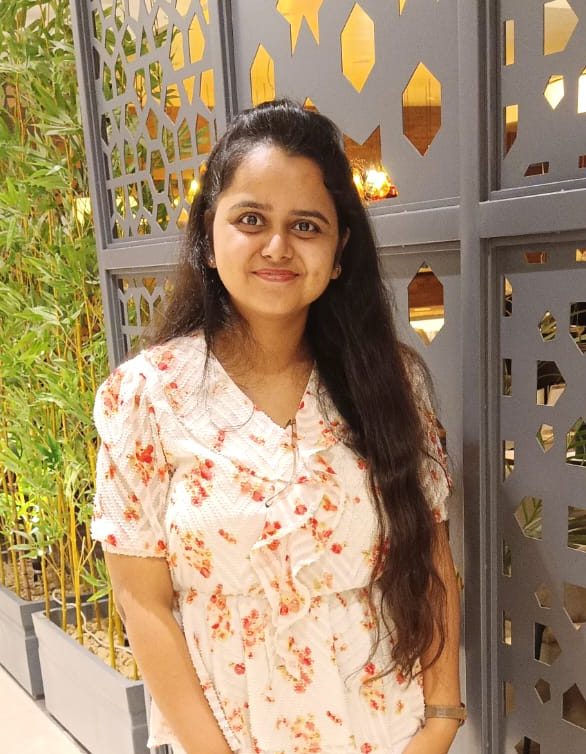
Muskan is a Marketing Analyst at Outgrow. She is working on multiple areas of marketing. On her days off though, she loves exploring new cafes, drinking coffee, and catching up with friends.

